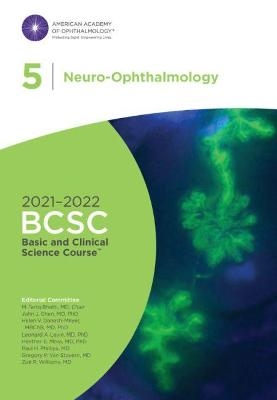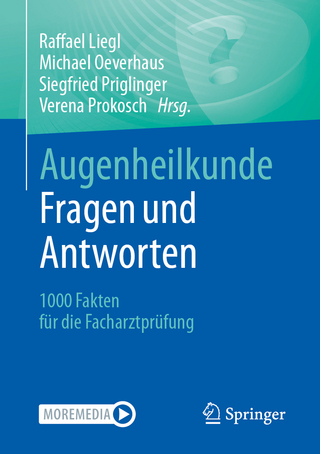
2021-2022 Basic and Clinical Science Course, Section 05: Neuro-Ophthalmology
Seiten
2021
American Academy of Ophthalmology (Verlag)
978-1-68104-443-9 (ISBN)
American Academy of Ophthalmology (Verlag)
978-1-68104-443-9 (ISBN)
- Titel ist leider vergriffen;
keine Neuauflage - Artikel merken
Provides a symptom-driven approach to the diagnosis and treatment of major neuro-ophthalmic conditions. Accordingly the emphasis is on the examination of the patient - both basic and extended - and the appropriate use of adjunctive studies to determine the status of the patient’s visual system as a whole.
Major revision
The Academy's Basic and Clinical Science Course™ is ophthalmology’s definitive source of clinical information. Practicing ophthalmologists and residents worldwide use the BCSC® to ensure the highest-quality patient care. Lean on the 100+ ophthalmologists who target the most beneficial clinical updates for this key ophthalmic reference each year.
Section 5 provides a symptom-driven approach to the diagnosis and treatment of major neuro-ophthalmic conditions. Accordingly, the emphasis is on the examination of the patient — both basic and extended — and the appropriate use of adjunctive studies to determine the status of the patient’s visual system as a whole.
Several chapters were substantially updated for this major revision, including the chapter on imaging in neuro-ophthalmology, which contains a new section devoted to interpreting optical coherence tomography results, and the chapter on functional neurological symptom (conversion) and related disorders, which includes an overview of the most recent diagnostic categorization of these disorders.
An overview of the anatomy of visual pathways is accompanied by numerous illustrations. For this edition, a significant number of videos, activities on orbital anatomy and the visual pathways, and an animation demonstrating visual snow have been added to increase understanding. Print users have access to the videos and activities.
Upon completion of Section 5, readers should be able to:
Explain a symptom-driven approach to the assessment of patients with common neuro-ophthalmic clinical manifestations and state an appropriate differential diagnosis.
Describe a plan for the immediate management of patients with neuro-ophthalmic emergencies.
Describe eye movement disorders and their anatomical relationship to the ocular motor system.
Explain functional neurological symptom (conversion) disorder, factitious disorder, and malingering, and list the various clinical tests that are used to evaluate functional vision loss.
Describe the neuro-ophthalmic effects of the most common neurologic and systemic disorders affecting the visual and ocular motor systems.
Major revision
The Academy's Basic and Clinical Science Course™ is ophthalmology’s definitive source of clinical information. Practicing ophthalmologists and residents worldwide use the BCSC® to ensure the highest-quality patient care. Lean on the 100+ ophthalmologists who target the most beneficial clinical updates for this key ophthalmic reference each year.
Section 5 provides a symptom-driven approach to the diagnosis and treatment of major neuro-ophthalmic conditions. Accordingly, the emphasis is on the examination of the patient — both basic and extended — and the appropriate use of adjunctive studies to determine the status of the patient’s visual system as a whole.
Several chapters were substantially updated for this major revision, including the chapter on imaging in neuro-ophthalmology, which contains a new section devoted to interpreting optical coherence tomography results, and the chapter on functional neurological symptom (conversion) and related disorders, which includes an overview of the most recent diagnostic categorization of these disorders.
An overview of the anatomy of visual pathways is accompanied by numerous illustrations. For this edition, a significant number of videos, activities on orbital anatomy and the visual pathways, and an animation demonstrating visual snow have been added to increase understanding. Print users have access to the videos and activities.
Upon completion of Section 5, readers should be able to:
Explain a symptom-driven approach to the assessment of patients with common neuro-ophthalmic clinical manifestations and state an appropriate differential diagnosis.
Describe a plan for the immediate management of patients with neuro-ophthalmic emergencies.
Describe eye movement disorders and their anatomical relationship to the ocular motor system.
Explain functional neurological symptom (conversion) disorder, factitious disorder, and malingering, and list the various clinical tests that are used to evaluate functional vision loss.
Describe the neuro-ophthalmic effects of the most common neurologic and systemic disorders affecting the visual and ocular motor systems.
| Erscheinungsdatum | 01.09.2021 |
|---|---|
| Verlagsort | San Francisco |
| Sprache | englisch |
| Gewicht | 1024 g |
| Themenwelt | Medizin / Pharmazie ► Medizinische Fachgebiete ► Augenheilkunde |
| ISBN-10 | 1-68104-443-9 / 1681044439 |
| ISBN-13 | 978-1-68104-443-9 / 9781681044439 |
| Zustand | Neuware |
| Haben Sie eine Frage zum Produkt? |
Mehr entdecken
aus dem Bereich
aus dem Bereich
Ein systematischer Ansatz
Buch | Hardcover (2022)
Urban & Fischer in Elsevier (Verlag)
CHF 369,95
1000 Fakten für die Facharztprüfung
Buch | Softcover (2023)
Springer (Verlag)
CHF 97,95


